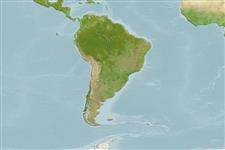Common names from other countries
Classification / Names / Names
Namen | Synonyme | Catalog of Fishes (gen., sp.) | ITIS | CoL | WoRMS
Environment: milieu / climate zone / depth range / distribution range
Ökologie
; tiefenbereich 0 - 15 m (Ref. 105490). Subtropical; 16°S - 41°S, 75°W - 70°W
Southeast Pacific: Peru and Chile.
Length at first maturity / Size / Gewicht / Alter
Maturity: Lm ? range ? - ? cm
Occurs in the lowermost intertidal zone and immediate subtidal zone to 15 m on upper surfaces of rocks. In deep tide pools at low tide (Ref. 105490). Inhabits sublittoral rocky zone (Refs. 106267, 106270). Found on matrices of the tunicate Pyura praeputialis (Ref. 66198). Members of the Family Fissurellidae are herbivorous, grazing on algae (Ref. 104247).
Life cycle and mating behavior
Geschlechtsreife | Fortpflanzung | Ablaichen | Eier | Fecundity | Larven
Members of the order Patellogastropoda are mostly gonochoric and broadcast spawners. Life cycle: Embryos develop into planktonic trocophore larvae and later into juvenile veligers before becoming fully grown adults.
Servicio Nacional de Pesca y Acuicultura. 2011. (Ref. 90098)
IUCN Rote Liste Status (Ref. 130435)
CITES Status (Ref. 108899)
Not Evaluated
Not Evaluated
Bedrohung für Menschen
Harmless
Nutzung durch Menschen
Fischereien: kommerziell
| FishSource |
Tools
Mehr Information
Alter/GrößeWachstumLänge-GewichtLänge-LängeMorphologieLarvenDichte
Internet Quellen
Estimates based on models
